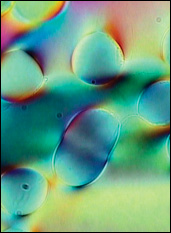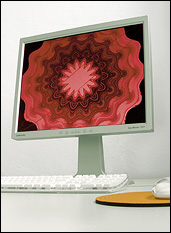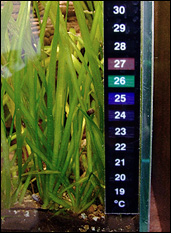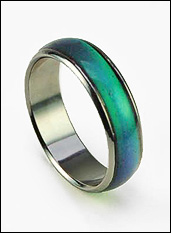A liquid crystal is an assembly of molecules that is partly ordered—for example, its molecules can be ordered (rigid) like a crystal along a vertical direction, while remaining unordered (flowing) like a liquid in a horizontal one. It may have several possible orderings, called "phases." Liquid crystals can be be manipulated by heat and cold, and electric, magnetic or mechanical forces. There are two kinds of liquid crystals: those that undergo phase changes due to temperature (themotropics) and those that undergo phase changes due to the density of a liquid, such as water (lyotropics).
Liquid crystals are everywhere. They are used in all kinds of display devices including computer monitors and laptop screens, TVs, clocks, visors, and navigation systems. Each pixel in a monitor is an assembly of liquid crystals controlled by its own electromagnetic field. The field changes the orientation of the liquid crystals, affecting how much light can be transmitted through them, in turn producing the images you see on screen.
Liquid crystals can also be found someplace you might not expect: living things! Our bodies are 98% water, and water determines most of the processes that occur in them. Therefore it is not surprising to encounter lyotropic liquid crystal phases in the wall of the cells of all living things. These phases allow the cells to remain flexible and perform different tasks.
How is MSE at UMD Working with Liquid Crystals?
Liquid Crystals and Human Health: MSE Professor Luz Martínez-Miranda is investigating the effects of adding nanometer-sized particles to a liquid crystal. This could provide researchers with a safe model system they can use to predict what would happen to the liquid crystal structure in living cell walls when they are exposed to nanoparticles, whether they are drugs intended to do good or toxins that could harm.
Liquid Crystals and Solar Engery: MSE Professors Luz Martínez-Miranda and Lourdes G. Salamaca-Riba are creating hybrid liquid crystal/nanoparticle photovoltaic systems that could pave the way for thin, flexible, inexpensive solar energy solutions. More...
Watch a materials video demonstration about liquid crystals:
 Now You See Me, Now You Don't!
Now You See Me, Now You Don't!
Polymer dispersed liquid crystals (PDLCs) can be applied as a coating to windows and simple displays. PDLCs are made from a mixture of a liquid crystal and a polymer. The polymer is isotropic, meaning its optical properties are always the same—in this particular case, transparent. But the liquid crystal in the coating is anisotropic, meaning its optical properties can change. Initially, the glass appears to be frosted. When an electrical field is applied to the coating, the liquid crystal reacts by realigning its molecular structure to match that of the transparent polymer's, and almost instantly the window becomes clear! (In this sample movie, the liquid crystals appear to darken as they realign and we see through them, the clear polymer and the glass to the dark background.) PDLCs have been used for privacy, in exhibits, for safety visors used by pilots, and in heads-up displays.
See a movie demonstrating a polymer dispersed liquid crystal »



